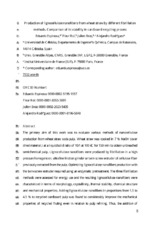Production of lignocellulose nanofibers from wheat straw by different fibrillation methods. Comparison of its viability in cardboard recycling process
Autor
Espinosa, E.
Rol, Fleur
Bras, Julien
Rodríguez Pascual, Alejandro
Editor
ElsevierFecha
2019Materia
Lignocellulose nanofibers (LCNFs)Mechanical nanofibrillation
Process energy efficiency
Recycled Cardboard
Mechanical Properties
METS:
Mostrar el registro METSPREMIS:
Mostrar el registro PREMISMetadatos
Mostrar el registro completo del ítemResumen
The primary aim of this work was to evaluate various methods of nanocellulose production from wheat straw soda pulp. Wheat straw was cooked in 7% NaOH (over dried material.) at a liquid/solid ratio of 10/1 at 100 °C for 150 min to obtain unbleached semichemical pulp. Lignocellulose nanofibers were produced by fibrillation in a high pressure homogenizer, ultrafine friction grinder or twin-screw extruder of cellulose fiber previously extracted from the pulp. Optimizing lignocellulose nanofibers production with the twin-screw extruder required using an enzymatic pretreatment. The three fibrillation methods were assessed for energy use and the resulting lignocellulose nanofibers were characterized in terms of morphology, crystallinity, thermal stability, chemical structure and mechanical properties. Adding lignocellulose nanofibers in proportions from 1.5 to 4.5% to recycled cardboard pulp was found to considerably improve the mechanical properties of recycled fluting even in relation to pulp refining. Thus, the addition of lignocellulose nanofibers doubled Young's modulus and burst index. The technical and energy feasibility of both processes was examined in order to evaluate the suitability of the different nanocellulose production methods for producing cardboard reinforcing agents as compared to conventional mechanical refining methods. This technology provides an economically more viable and competitive production process than industrial mechanical refining, presenting this technology as a candidate to improve the cardboard recycling process, at a lower cost, and increase the maximum recycling cycles that the product can support.

